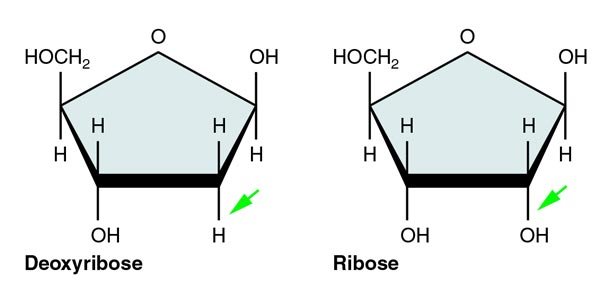We wish to suggest a structure for the salt of deoxyribose nucleic acid (DNA).
This structure has novel features which are of considerable biological interest.
Watson & Crick, 1953
DNA and RNA are the two types of nucleic acids (a class of macromolecules in the cells) present in all prokaryotic and eukaryotic organisms. Both are essentially the polymers of nucleotides and have immense role in the storage and expression of genetic information in an organism. DNA and RNA allow the storage of genetic information for long period of time without any changes in the genetic constitution of the organism. The presence of two categories of nucleotides also allows the decoding of genetic information during protein synthesis by the process of transcription and translation. The current post describes the similarities and differences between DNA (deoxyribonucleic acid) and RNA (ribonucleic acid).
Similarities between DNA and RNA
Ø Both DNA and RNA can acts as genetic material.
Ø Both are polymers of nucleotides.
Ø Both DNA and RNA are linear structures with secondary and super-secondary arrangements.
Ø Both contain purines and pyrimidines.
Ø Both DNA and RNA contain pentose sugar.
Ø In DNA and RNA the adjacent nucleotides are connected by 3’-5’ phosphodiester bonds.
Ø Both DNA and RNA absorb UV light at 260 nm.
Ø Both DNA and RNA contain hydrogen bonds
| You may also like NOTES in... | ||
|---|---|---|
| BOTANY | BIOCHEMISTRY | MOL. BIOLOGY |
| ZOOLOGY | MICROBIOLOGY | BIOSTATISTICS |
| ECOLOGY | IMMUNOLOGY | BIOTECHNOLOGY |
| GENETICS | EMBRYOLOGY | PHYSIOLOGY |
| EVOLUTION | BIOPHYSICS | BIOINFORMATICS |
Difference between DNA and RNA
Sl. No. DNA RNA
1 Deoxyribonucleic acid Ribonucleic acid
2 Sugar molecule in DNA is Deoxyribose(the ribose sugar in DNA is deoxygenated at its 2’ position. The 2’ region possesses - H). Sugar molecule in RNA is Ribose (Oxygenated at its 2’ position. The 2’ region possesses – OH).
3 Usually DNA is double stranded structure (single stranded DNA also occurs). Usually RNA is single stranded (double stranded RNA do occurs).
4 DNA occurs as double helical conformation. Usually occurs as irregularly folded structures.
5 Helix geometry in DNA is B form (A and Z form of DNA do occur). The helix geometry in RNA is A form.
6 DNA is a highly stable molecule. Stability of RNA is less.
7 DNA acts as the carriers of genetic information. Usually acts as the intermediate molecule between genetic material (DNA) and its expression molecules (Proteins). In some viruses, the RNA also acts genetic materials.
8 Nitrogen bases of DNA are:
Purines- Adenine and Guanine
Pyrimidines: Thymine and Cytosine.
Nitrogen bases of RNA are:
Purines: Adenine and Guanine
Pyrimidines: Uracil and Cytosine.
9 Base pairing in DNA: A – T and G – C. Base pairing in RNA: A – U and G – C .
10 In DNA the number of purine is always equal to the number of pyrimidine. Number of purine will never be equal to pyrimidine.
11 Purine to pyrimidine ratio in DNA is always 1 : 1. Purine to pyrimidine ratio highly varies.
12 DNA follows the Chargaff’s rule. RNA does not follow the Chargaff’s rule.
13 DNA very rarely contain unnatural or bases other than A, T, G, C. Some RNA contain unnatural bases such as Pseudouridine and 4-thiouridine
14 DNA is usually associated with histone proteins in eukaryotes. RNA is not associated with histone proteins.
15 DNA can interact with nucleoproteins to form chromatin and chromosomes. Can interact with a variety of proteins, but it cannot form chromatin or chromosomes.
16 DNA is located mainly in the nucleus. DNA is also present in cell organelles such as Mitochondria and Chloroplast. RNA is found in the nucleus, cytoplasm and cell organelles such as Mitochondria and Chloroplasts.
17 DNA has comparatively smaller groves and hence they are protected from enzymatic attacks. RNA has comparatively larger groves and hence they are highly vulnerable to the attack of hydrolytic enzymes.
18 DNA is stale in alkaline condition because it lacks the – OH group 2’ position. RNA is unstable at alkaline condition due the presence of – OH at 2’ portion. The – OH group at 2’ position is highly reactive.
19 DNA do not have the catalytic activity Some RNA molecules possess catalytic activity (Ribozymes). Example: Peptidyltransferase.
20 DNA is extremely sensitive to UV radiation. RNA is comparatively resistant to UV radiation.
21 The quantity of DNA is fixed in the cells. The quantity of RNA is not fixed; it is highly variable in different states of cell cycle.
22 DNA is comparatively long structures with high molecular weight. DNA contains millions of base pairs. RNA is comparatively shot structures, usually few to 15000 nucleotides.
23 Based on function only one type of DNA is found in all organisms. Different types of RNA is found in the cells based on its functions such as rRNA, tRNA, mRNA, siRNA, miRNA, snRNA etc.
24 DNA cannot occur in the cytoplasm in free state. RNA can occur in the cytoplasm in free state
25 The deoxyribose sugar residue in DNA is C2’ endo form. The ribose sugar residue in RNA is C3’ endo form.
26 DNA stain blue with azureph thalate dye. RNA stain red with azureph thalate dye.
27 DNA stain green with pyronin dye. RNA stain red with pyronin dye.
| You may also like... | ||
|---|---|---|
| NOTES | QUESTION BANK | COMPETITIVE EXAMS. |
| PPTs | UNIVERSITY EXAMS | DIFFERENCE BETWEEN.. |
| MCQs | PLUS ONE BIOLOGY | NEWS & JOBS |
| MOCK TESTS | PLUS TWO BIOLOGY | PRACTICAL |

<<Back to Molecular Biology Notes

very good
Hi there,
You are doing a great job. Can I print the short lecture notes? I have tried but I was not able to do so.